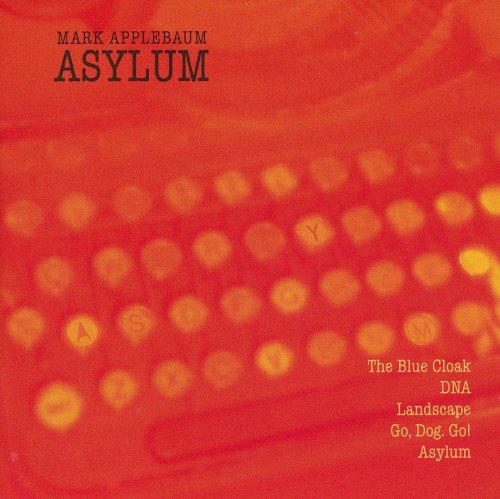Mark Applebaum - Asylum (2006)

Artist: Mark Applebaum
Title: Asylum
Year Of Release: 2006
Label: innova
Genre: New Classical, Avant-Garde
Quality: FLAC (tracks+.cue, log)
Total Time: 1:12:42
Total Size: 327 MB
WebSite: Album Preview
Tracklist:Title: Asylum
Year Of Release: 2006
Label: innova
Genre: New Classical, Avant-Garde
Quality: FLAC (tracks+.cue, log)
Total Time: 1:12:42
Total Size: 327 MB
WebSite: Album Preview
01. The Blue Cloak (2005) for sextet & soloist (21:52)
02. DNA (2004) for guitar (7:49)
03. Landscape (2003) for piano trio (6:08)
04. Go, Dog, Go! (1999) for percussion duo (16:39)
Asylum (2004) for nonet & percussion soloist (20:13)
05. Incubation (4:20)
06. Inventory (3:23)
07. Echolalia (4:19)
08. Insight & Interjections (4:57)
09. Cadenza & Relapse (3:11)
Champ d'Action (1):
Jaan Bossier: conductor
Sabine Warnier: flute
Sabine Uytterhoeven: clarinet
Arne Deforce: cello
Fedor Teunisse: percussion
Yutaka Oya: piano
Stefan Prins: piano interior
Mark Applebaum: mouseketier and live electronics
Magnus Andersson: guitar (2)
Harmida Piano Trio (3):
Dawn Harms: violin
Emil Miland: cello
Laura Dahl: piano
Skin & Bones (4):
Terry Longshore & Brett Reed: percussion
exxj - Ensemble XX. Jahrhundert (5-9)
Peter Burwik: conductor
Renate Linortner: flute
Daniel Horth: clarinet
Andrej Kasijan: horn
Mark Gaal: trombone
Lajos Horvath: guitar
Ivana Pristasova: violin
Wladimir Kossjanenko: viola
Attila Pasztor: cello
Harald Jach: contrabass
Berndt Thurner: percussion soloist
Recorded at deSingel, Antwerp, Belgium, September 30, 2005. (1)
Recorded at PINK, May 6, 2005 (2)
Recorded at PINK, November 13, 2005 (3)
Recorded at PINK, August 3, 2003 (4)
Live recording during the Vienna Modern Festival at the Schomer-Haus, Klosterneuberg, Austria, November 14, 2004 (5-9)
Engineered and edited by Maarten Buyl, Peter Swinnen, and Mark Applebaum (1)
Engineered and edited by Mark Applebaum (2,3,4)
Engineered by Karlheinz Essl (5-9)
Mark Applebaum, producer
Bob DeMaa, remastering
Innova is supported by an endowment from the McKnight Foundation
Philip Blackburn: director, design
Chris Campbell: operations
A jazz pianist and a builder of junkyard electro-acoustic instruments as well as a former composition pupil of Brian Ferneyhough, Mark Applebaum brings out the carnival beneath complexity’s surfaces. The excellent opening track, The Blue Cloak, demonstrates precisely this bi-polarity. It was inspired by Breughel’s ‘teaming figure’ painting Netherlandish Proverbs, a typical partly comic, partly disturbing tableaux of characters who illustrate in their bizarre daily rituals a total of 100 proverbs and sayings. The music, led by a substantial partly-improvised part for Applebaum’s found object sound sculpture the ‘mouseketier’, scurries and scatters itself about the room, sounding just like the Tom and Jerry score Ferneyhough himself may yet write. A serious-comic schizophrenia animates other works on this CD. DNA explores the notion of ‘neuromuscular economy’, whereby the virtuosity of a densely notated guitar solo is undermined as essentially the same four lines of music are looped round and round, detuning as they go. The percussion duet Go, Dog. Go! follows an uexpected route to rich rhythmic complexity, using rock and pop grooves (Led Zeppelin, James Brown, the Spice Girls) played at their original speeds, but stripped of all timbre, pitch and lyrics. It takes a keen ear to hear most of these for what they are, but the rhythmic diversity that results quashes any expectation of 4/4 monotony. The record’s title work turns such contradictory characteristics to more serious intent. It is scored for instrumental nonet and a theatrical percussion soloist, who is the subject of 22 mental disorders that play out in the piece’s 5 movements, the surrounding ensemble functioning periodically as the superego or a council of elders sitting in judgement. As with the rest of the CD, it is musically convincing, but for such a theatrical work (in the third movement, for example, the percussionist enacts a detailed series of Dadaist rituals that culminate in the bursting of a ballon in which is concealed the triangle beater to be used to begin the fourth movement) it is of course not possible to gauge fully the work’s effect. However, with the aid of sleevenotes, enough of the assorted manias comes through; overall this is another fine record from a consistently interesting composer. (Innova)

![Tomasz Stańko - Zamek mgieł (Polish Radio Sessions vol. 3/6) (2025) [Hi-Res] Tomasz Stańko - Zamek mgieł (Polish Radio Sessions vol. 3/6) (2025) [Hi-Res]](https://www.dibpic.com/uploads/posts/2025-12/1765795906_cover.jpg)

![Betty Carter - The Music Never Stops (2019) [Hi-Res] Betty Carter - The Music Never Stops (2019) [Hi-Res]](https://www.dibpic.com/uploads/posts/2025-12/1765896843_bcmn500.jpg)




![NYO Jazz - Live in Johannesburg (Live) (2025) [Hi-Res] NYO Jazz - Live in Johannesburg (Live) (2025) [Hi-Res]](https://www.dibpic.com/uploads/posts/2025-12/1765894703_zwp14vk90corb_600.jpg)